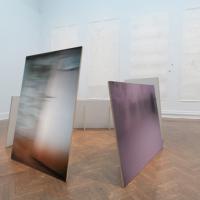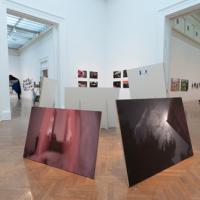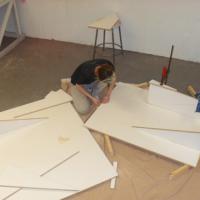“What would be more natural… than to knock at the door of dreams and inquire of them the bearings which would bring us closer to the basic facets of human existence?”
-Carl Jung, 1970.[1]
Presently working within the medium of photography, sculpture and installation, I investigate the universal qualities of personality and concerns of viewership through the use of the ‘self’ and inquiries into the ‘personal.’
In Only a Dream, Only in a Dream investigates definitions of consciousness as inspired by my own dream content and universal dreaming processes. Personal and fertile interests lie in dream states, imagery dissection and content interpretation; I sculpturally present the question that has long interested me: How do we define consciousness? I integrate layers such as horror, enlightenment, control, fear, and solutions as influences to the conceptual themes of the work.
I strive to integrate ideas and media with inquiry, which motivated the conception of this body of work. My internal struggles in understanding why we dream, why we dream the imagery we do and its conceptual and literal influences on and from the waking life provokes sharing and ideally a relational aesthetic on the ideas around dreaming and imagery.
On relational aesthetics and concepts, the inquiry has opened parallels such as the similarity between objective/subjective artistic viewer interpretation with objective/subjective dream content and the intuition of the dreamer as the artist. Is the artist a dreamer, and is the dreamer an artist?
The research of psychoanalysts, physiotherapists and semiotics have presented cultural, physical and mental investigations and revelations about conscious/unconscious states of dreaming; the placement of artistic analysis could reveal deeper abstractions and critical associations such as a possible delineation between conscious and unconscious or the act of dreaming as an act of living.
Interestingly, the idea that a dream can instigate and birth ideas and solutions within an unconscious format to issues that exist on a conscious plane provides an acute parallel to In Only a Dream, Only in a Dream; the singularity of the image(s) is focally equated with the wholeness of the grouped objects. One subjective justification would suggest that since the dream has overarching purposes sometimes so basic that they become overlooked and that upon waking the dream simply does not cease its beckoning towards enlightenment and bewilderment, the installation of the work represents the dream’s manifestation, its juxtaposition into our waking world.
For the work, it was important to assert the concept of dreaming to be physical, heavy, and aware. The exposing of wood grain and the angled display format of each image recognizes that the dream is dreamer-specific, as raw material is worth refinement and coexistent with our ‘conscious thoughts.’
By creating large sculptural installations of wood and digital prints, I attempt to remove photography from the wall to parallel a removal, or moving away, from (and not in entirety, but majority) the psychoanalytical dominance of dream interpretation and justification. I also endeavor to harmonize image with sculptural object; a manifested physical, dialogical space is specialized for the viewers to observe, question or criticize the relative ideas of consciousness.
I do not seek to provide a universal answer for each dream or dreamer but to explore a continuing process of theorizing a dream’s worth for the individual and the rest of the world; and because as my own dreams increasingly rule my waking world more than the waking world does, a disturbance of concern and distraction, I embrace the horror and enlightenment for what it is, not comprehensively understanding what it is yet…
WORKS CITED
- Copleston, Frederick S.J. (1994). A History of Philosophy: Modern Philosophy From the French Enlightenment to Kant. Vol. VI. New York, New York: Doubleday Dell Publishing Group. p. 193-196, 273-275.
- Custance, John. (1952). Wisdom, Madness & Folly: The Philosophy of a Lunatic. New York, New York: Pellegrini & Cudahy. p. i-iv, 60-67.
- Forrester, Michael. (2000). Psychology of the Image. London, England: Routledge. p. 50-65.
- Freud, Sigmund. (2003). The Uncanny. (From Collection of Essays, originally written 1919 and published 1941.) London, England: Penguin Books.
- Gamwell, Lynn. (2000.) Dreams 1900-2000: Science, Art and the Unconscious Mind. (Published in conjunction with the exhibition of same title.) Ithaca, New York: Cornell University Press.
- Greene, Gayle. (2002.) Insomniac. Los Angeles, California: University of California Press. p. 43-46, 135-138, 234-240.
- Jung, Carl. (1970). Civilization in Transition (The Collected Works of C. G. Jung, Volume 10.) Princeton, New Jersey: Princeton University Press. p. 185-187.
- Krause, Jim. (2005). Photo Idea Index. Cincinnati, Ohio: F&W Publications.
- Mahon, Eugene, MD. (2005). Dreams of Architecture and the Architecture of Dreams (Abstract). Annual of Psychoanalysis, 33: 25-37.
- Piaget, Jean. (1951). The Child’s Conception of the World. London, England: Routledge and Kegan Paul, LTD. p 88-122.
- Pylkkänen, Paavo T. I. (2006.) The Architecture of Consciousness (Abstract), in Mind, Matter and the Implicate Order. Frontiers Collection, 2007, 93-155.
- Quenk, Alex T. & Naomi L. (1995). Dream Thinking. Palo Alto, CA: Psychologists Press, Inc. p. 1-105.
- Zebra (screen name). (11 March 2011.) The Built Environment: The architecture of dreams. Retrieved on 25 March 2011 from <http://tbecolumn.wordpress.com/2011/03/11/the-architecture-of-dreams/>.
[1] Jung, Carl. (1970). Civilization in Transition (The Collected Works of C. G. Jung, Volume 10.) Princeton, New Jersey: Princteon University Press.





